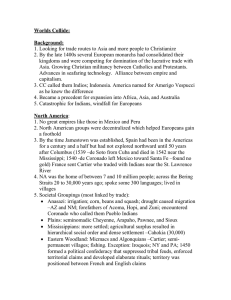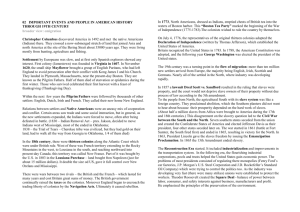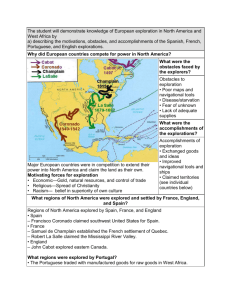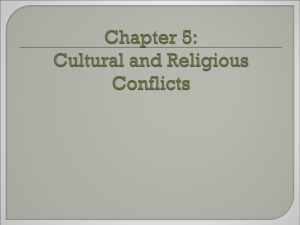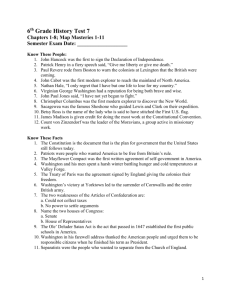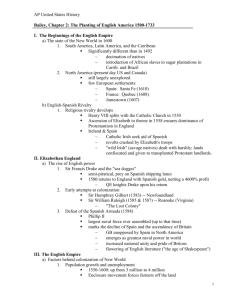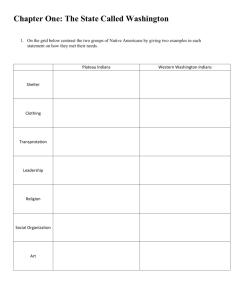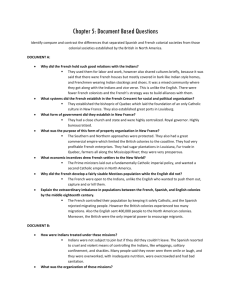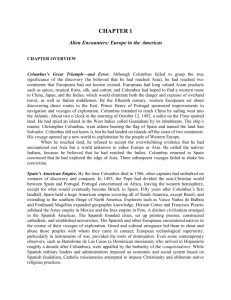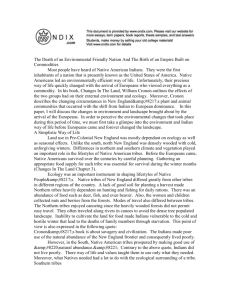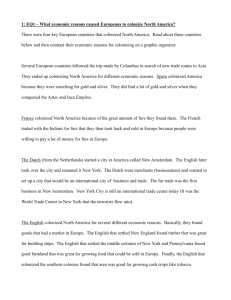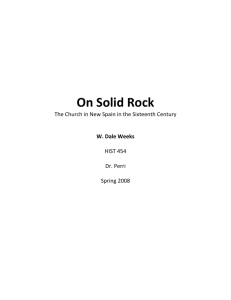Worlds Collide:
advertisement
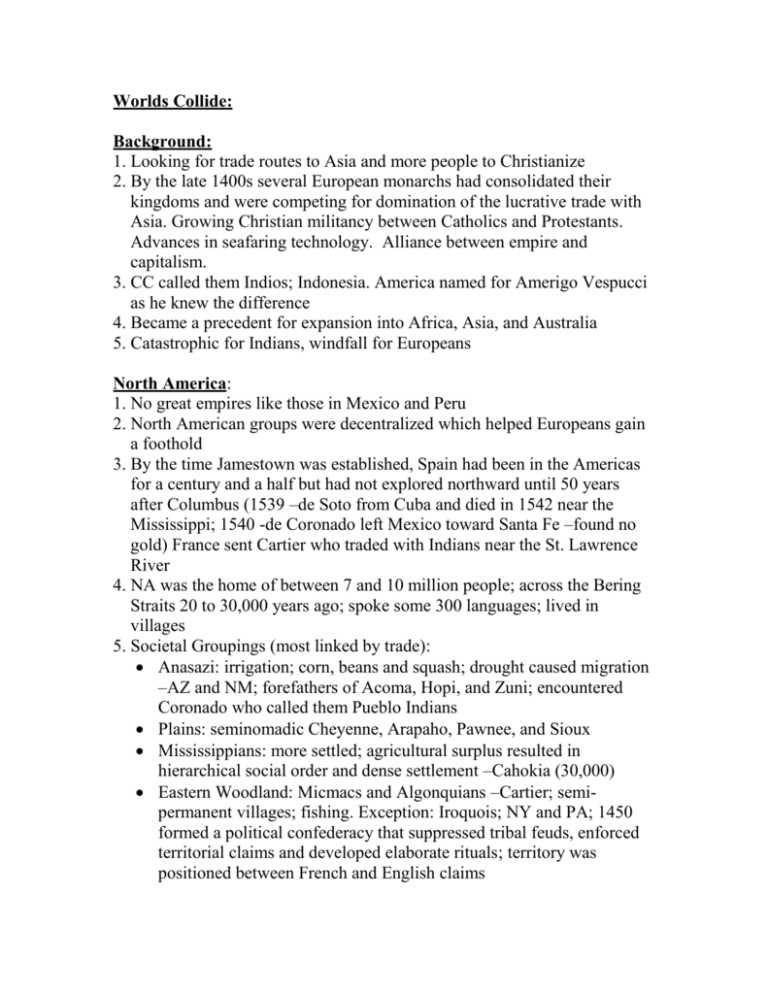
Worlds Collide: Background: 1. Looking for trade routes to Asia and more people to Christianize 2. By the late 1400s several European monarchs had consolidated their kingdoms and were competing for domination of the lucrative trade with Asia. Growing Christian militancy between Catholics and Protestants. Advances in seafaring technology. Alliance between empire and capitalism. 3. CC called them Indios; Indonesia. America named for Amerigo Vespucci as he knew the difference 4. Became a precedent for expansion into Africa, Asia, and Australia 5. Catastrophic for Indians, windfall for Europeans North America: 1. No great empires like those in Mexico and Peru 2. North American groups were decentralized which helped Europeans gain a foothold 3. By the time Jamestown was established, Spain had been in the Americas for a century and a half but had not explored northward until 50 years after Columbus (1539 –de Soto from Cuba and died in 1542 near the Mississippi; 1540 -de Coronado left Mexico toward Santa Fe –found no gold) France sent Cartier who traded with Indians near the St. Lawrence River 4. NA was the home of between 7 and 10 million people; across the Bering Straits 20 to 30,000 years ago; spoke some 300 languages; lived in villages 5. Societal Groupings (most linked by trade): Anasazi: irrigation; corn, beans and squash; drought caused migration –AZ and NM; forefathers of Acoma, Hopi, and Zuni; encountered Coronado who called them Pueblo Indians Plains: seminomadic Cheyenne, Arapaho, Pawnee, and Sioux Mississippians: more settled; agricultural surplus resulted in hierarchical social order and dense settlement –Cahokia (30,000) Eastern Woodland: Micmacs and Algonquians –Cartier; semipermanent villages; fishing. Exception: Iroquois; NY and PA; 1450 formed a political confederacy that suppressed tribal feuds, enforced territorial claims and developed elaborate rituals; territory was positioned between French and English claims Northwest: lived undisturbed until the late 18th century 6. Contrasts between Europeans and Indians: Nature and religion: Nature was infused with spiritual forces rather than separate from them –Animism; created stable relationship with the environment Land and property: had territorial boundaries but worked land collectively; success of the group more than the individual Gender roles: matrilineal –power from the mothers side; divorce simple and children remained with the mother; women cultivated the crops and men hunted Political organization: small political units; democratic in nature Europeans were monotheists; missionary in nature; others were infidels Dominated nature in which humans were on top of the hierarchy Land was to be closed in and owned by individuals; economic and political success rested on land ownership Patrilineal –men dominated women and controlled households; Catholics forbid divorce Governments were hierarchical with monarchs Great Britain: 1. In 1500 was politically and economically too weak to challenge Spain; 3 million in population; Henry VIII broke with Rome (he and EI) – centralized the monarchy’s bureaucracy, regularized the Crown’s relationship with Parliament, and courted urban merchants as allies against landed nobles. Between 1530 and 1650, England’s population doubled creating surplus labor. Elizabeth I encouraged ‘privateering’ in return for a share of the plunder; took around 1/3 of all gold heading for Spain –money helped finance the colonies 2. Defeated the Spanish Armada in 1588 3. What was left in the new world was land: New England –furs, timber and fish; Virginia –tobacco (Spanish tobacco from the West Indies); Barbados and Jamaica –sugar (most profitable) 4. Conquering indigenous peoples: professed to get along when they were vulnerable; use of Indian labor diminished by disease; copied Spanish plantation system from the Caribbean using Africans (went from indentured to slaves –mostly from the Dutch) 5. Colonization: British established ‘settler colonies’ dominated by whites (model derived from experiences in Ireland in the 1500s –including prejudice against ‘others’ and colonization through migration and settlement). 700,000 settlers in 1600s –spurred by the enclosure movement, religious persecution, and dislocations due to civil war between royalists and parliament; by 1700 had removed most Indians east of Mississippi; used urban merchants, private investors, and loyal landowners to support colonization –Private joint-stock groups such as the Massachusetts Bay and Virginia Companies and individual proprietors such as Lord Baltimore and Wm. Penn led to domination by family farms and businesses (some 2/3s of settlers were indentured); led to economic opportunities and a foundation for representative government. Local leaders enjoyed autonomy but after 1688 (Glorious Revolution) colonies placed directly under the crown; few intermarriages Spain had ‘exploitation colonies’ with fewer than 250,000 settlers; built missions to convert Indians and allowed the blending of Catholicism with indigenous religions; used encomienda system similar to feudalism; many intermarriages Columbian Exchange: (Ecological Imperialism?) 1. Mutual transfer of diseases, plants, and animals 2. CC on his 2nd expedition brought horses, cattle, sheep (wool), dogs, chickens, goats, sugar cane, onions, and banana trees. 3. Furs (which fueled the Anglo-French rivalry), timber and fish went to the Old World 4. Disease: smallpox, measles, influenza, typhus, and diphtheria (Indians had TB). 50 years after Columbus 500,000 in Hispaniola reduced to 2,000; smallpox killed 50% Aztecs; 50-90% of Indians in Caribbean and Mexico dead within 100 years (Black Death took 30% in Europe); cholera, malaria, and yellow fever were byproducts of the slave trade; disease moved inland ahead of settlers (1600 influenza contracted from French sailors killed 80% of Pennacooks allowed the Pilgrims to land -1630s small pox reduced the Iroquois by 50% -before L and C smallpox killed half of Indians between Mississippi and Rockies) Exception: white sailors gave syphilis to Indians (on the East coast, CC men took it back to Europe). By 1750 more slaves than Indians. 5. Food: From the New World came corn and potatoes (staple food for Ireland), beans, squash, peppers, tomatoes, peanuts, manioc –caused surge in population. From the Old World came wheat, rice, sugar, coffee, tobacco and hard liquor. Pigs (portable meat) and horses (changed the life of plains Indians –increased population; became nomadic and women’s status declined; wars among tribes –practice help them fend off white settlers better than eastern tribes.

